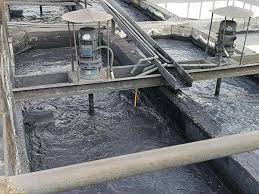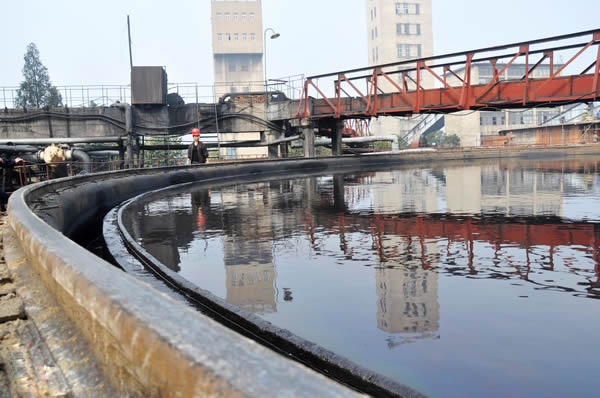Need to consume a lot of water resources for coal washing operations while improving the utilization value of coal in coal preparation plants. Under the new normal, the moderate and high-quality development of the global economy and society has put forward higher requirements for the clean production and utilization of coal.
Status of coal slime water
Among them, coal slime water is the industrial tailings water of the wet coal washing process in coal mines. According to incomplete statistics, the wastewater generated by coal washing processing plants exceeds 3.0×107t every year. The amount of water used for coal washing is huge and the slime water generated after coal washing contains various pollutants.

While wasting resources, it also pollutes surface water and groundwater. In view of this, realize the effective treatment of coal slime water has become one of the research priorities for the sustainable development of the coal preparation industry.
Introduction of coal slime water
The composition of coal slime water will change with the change of mining area, coal type and coal washing method.
- Relatively speaking, in the coking coal process, the coal slime content is large and the coal slime water concentration is high. Generally, the water (or magnetic tail) under the desliming screen is classified with a hydrocyclone, and then the coarse and fine coal slime is separated and dehydrated.
- But the thermal coal preparation plant is different, which is mainly reflected in the low concentration of slime water and the large amount of water. The amount of coarse slime is small, and the sorting is of little significance. Therefore, the magnetic tailings are generally concentrated with a hydrocyclone, dehydrated by the underflow into a product, concentrated by the overflow and filtered, and mixed with coal after crushing.
The composition of coal washing water is very complex, but it still has certain commonalities, mainly including the following points:
1. Most of the suspended particles in the slime water carry a strong negative charge on the surface, which is easy to form a colloidal dispersion system in water and has good stability. The reason is that most of the colloidal particles carry the same charge, which will form a strong electrostatic repulsion between them, and the higher the potential, the greater the repulsive force between the particles, and the more difficult it is to destroy the colloidal system formed in water. This charged colloid often has good adsorption properties, and can adsorb surrounding water molecules in water, thereby forming a water film on the surface of the particles. This layer of water film has a certain protective effect and can avoid the contact between different charged particles. Make the slime water more stable;
2. The precipitation and separation of high-concentration coal slime water is difficult, mainly due to the existence of a large number of fine particles in the water, most of which are small and cannot settle to the bottom by their own gravity;
3. For wastewater with better filtration performance, it can remove impurities in the water by means of pressure filtration dehydration. However, for coal slime water with a high concentration, due to the large resistance of coal slime, the filtration performance is poor, and it is difficult to achieve the effectiveness of the treatment simply by dehydration by pressure filtration, and the cost of wastewater treatment is high;
4. The concentration and viscosity of suspended solids are high, which are the main characteristics of coal slime water; coupled with the relatively low density of coal slime, the treatment difficulty is further increased.
Coal Slime Water Treatment Process
In the process system of coal preparation plant, the treatment of coal slime water (including sorting, recovery, dehydration, classification, concentration and clarification) is an extremely important link. The quality of the separation effect of the coal preparation plant, the quality of each product, and whether there is waste water discharge, which will cause the loss of coal slurry water and environmental pollution, etc. Management system has a lot to do with it.

In short, there are the following six types of coal slime water treatment processes:
1. Direct flotation separation→ tailings coal concentration → water pressure filtration. This process can quickly realize the effective closed-circuit circulation of coal slime water, improve the utilization rate of clean coal recycling, and enhance the economic benefits of enterprises. However, this process has large initial investment and high operating costs, and is only suitable for large-scale coking coal washing plants;
2. Slime dense medium separation → tailings coal concentration → water filter press. This process can achieve high-precision sorting of coarse slime with less investment, but the lower limit of recovery of clean slime is only 0.1mm, and the amount of tail coal is relatively large, which has certain pollution to the environment. Therefore, it is only suitable for Coal preparation yards that are all heavy medium and difficult to float coal operation;
3. Coal slime water dense medium separation → coarse slime recovery → fine slime concentration and filter press. The investment cost and operating cost of this method are lower than those of the direct flotation process, and it is suitable for easy-to-separate coarse coal slime with a density exceeding 1.6kg/L. At the same time, the amount of washed coal obtained by this method is large and difficult to dehydrate, and it is widely used in small coking coal preparation plants or thermal coal preparation plants;
4. Coal slime water concentration → direct recovery. Although the investment of this process is small, the economic benefits are limited, the dehydration of coal slime is difficult, and it is difficult to realize the closed-circuit circulation of coal slime water. It is mostly used in small coking coal preparation plants or thermal coal preparation plants;
5. Slime sedimentation tank. The investment and operation cost of this process are relatively small, but since the closed-circuit circulation of coal slurry water cannot be realized, it is more harmful to the environment and is only suitable for small coal preparation plants;
6. There is also a coal washing process suitable for alpine or water-deficient areas, that is, dry coal gangue separation process. This kind of process is simple, low in investment cost, saves water and energy, and has good economic benefits, but the sorting effect is not as good as wet separation.
At present, the coal preparation plant adopts the process of “cyclone-thickener-filter press (slime sedimentation tank)” for the treatment of coal slime water. Among them, the processing capacity of the equipment is the key to ensure the closed-circuit circulation of the slime water. The slime thickener is the main equipment for recycling slime.

The cyclone is mainly used for the control of the feed concentration of the slime recovery screen. A filter press is used for further recovery of fine slime. The slime settling tank can also be used to treat the under-screen water of the cyclone concentration and slime recovery screen.
With the continuous improvement of coal washing technology, from the perspective of protecting the environment or saving coal and water resources, these coal washing plants should fundamentally change the current status of the treatment and utilization of coal slime water, and choose a practical tailings water treatment process according to local conditions. Effective treatment of coal slime water is an inevitable demand for the sustainable development of national modernization. For coal preparation operations, organize professional technical forces to carry out targeted analysis and research, so as to formulate targeted coal slime water treatment processes. Realize the optimal treatment of coal slime water, effectively improve the recycling and utilization of water resources, and contribute to the green environment of nature.